| 1 | Black-necked spitting cobra |
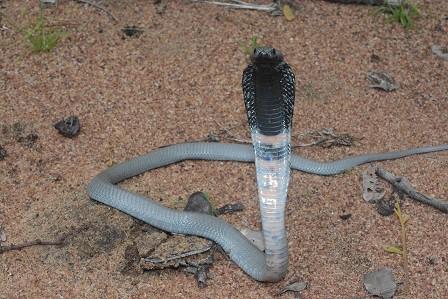
Maximum size: at least 220cm.
The most common spitting cobra in Africa, inhabiting a massive chunk of the centre. Naja nigricollis is nocturnal, and likes to hang out in tree trunk hollows and termite mounds. They also like to spit venom in people’s eye, and each globule contains 9.75mg of venom, easily beating the red spitting cobra of Ethiopia (2.64mg). The black-neck can spit 57 times in 20 minutes without tiring.
Black-necked spitting cobras range from the Atlantic coast to the Pacific. They inhabit countries such as Nigeria, Kenya, Angola, DRC, and Ghana, and are feared in all of them. Locals have many folk remedies which they rub into eyeballs, from human breast milk to a shrub called Indigofera pulchera.
As well as temporary blindness, the venom has weirder effects, as one man suffered from an eyeball so numb that doctors could poke it painlessly. The bite is equally nasty, killing 5-10% of untreated victims. Nigerians often mistake this cobra for the black mamba. They’re wrong about that, but they’re still correct when they rush indoors and lock up in a panic.
Naja nigricollis is as black as you’d expect, except the belly, which is brain pink. Black-necks regularly use the signature hood flare of all cobra species.
| 2 | Philippine spitting cobra |
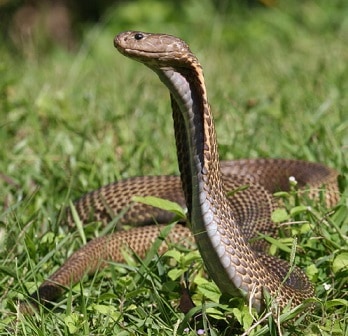
Maximum length: at least 160cm, possible 200cm on certain islands.
This spitty creature occupies the northern areas of the Philippines, including the large island of Luzon. Its colour varies significantly, from a baked brown to almost black mixed with banana yellow. The Philippine spitting cobra is particularly fond of water, but this can be almost anywhere, including ponds, rivers or large puddles in agricultural fields.
Philippine cobras are regarded as one of the world’s most dangerous snakes. Instead of the cloudy mist of a black-necked spitting cobra, this Philippine version sprays in dual thin jets. They can accurately spray a pair of eyes from 3 metres away, so if you open your bathroom door to find one staring at you, the situation is truly dire.
Meanwhile, their main venom has a unique toxin profile. Modern spitting cobras originate from ancestors 6.7-10.7 million years ago, but naja philippinensis has separated to have particularly neurotoxic venom, which rarely causes necrosis of the surrounding flesh. The toxins are cleanly injected, and then the main cause of death kicks in – respiratory paralysis.
Filipino rice farmers are the main victim of this spitting cobra. In one area, the naja philippinensis bite rate was 107.2 per 100,000 people, many of whom will have been sprayed and clutching their eyes in agony first.
| 3 | Indochinese spitting cobra |
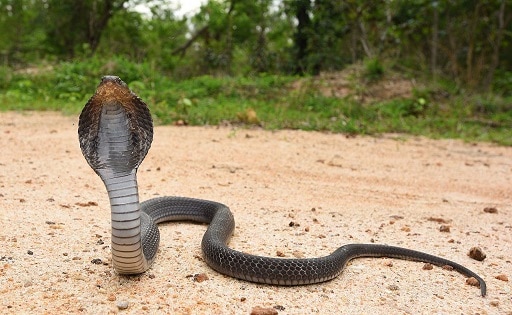
Maximum length: 160cm.
Thailand’s signature spitting cobra. This version has the shortest spit distance of any, at only 1 metre. However, they make up for this with accuracy, and their nimble, swift movements. Thai snake experts warn never to underestimate this spitting cobra.
A 2021 study found that this is a mist-er, releasing a venom cloud towards people’s eyes rather than jets. The result of a spray to the eyes is instant, incapacitating pain. Be warned – this spitting cobra doesn’t need to have its neck flared to spit, the traditional defensive posture.
The Indochinese spitting cobra inhabits all of Thailand’s mainland, skipping the southern peninsula regions bordering Malaysia. They’re a paler spitting cobra, but their base of scales is actually grey; the white patches are simply extremely large.
Occasionally you can find Thai restaurants serving up its meat. Thankfully, this no longer has the ability to spit. Despite their short range, Indochinese spitting cobras are able to spit repeatedly without tiring.
| 4 | Red spitting cobra |
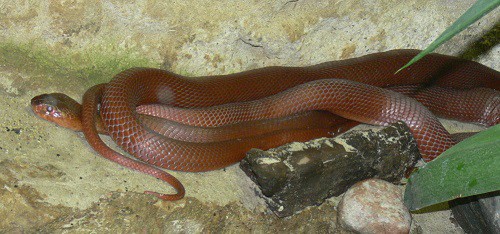
Maximum length: 150cm.
As the name foretold, this is the reddest of the world’s spitting cobras, easily separable from the nearby black-neck. Another two ID signs are a black patch on its neck, and a back mark below its eye.
The red spitting cobra delivers relatively little venom per spit, at just 2.64mg, but in all other aspects it’s a horror. This Ethiopian species can spit 40 times in one encounter. It takes until the 20th spit for the venom to become diluted, and the cobra can spit accurately from 2.5 metres away. As they spray, the red spitting cobra twists its head slightly so that the venom covers a larger area.
Red spitting cobras can often be found in savannahs in Kenya and Ethiopia. After heavy rains, pools fill up and streams flow anew, causing their main prey of frogs and toads to come out in abundance. Red spitting cobras have a particularly evil hunting method: they spray the victim, then track them through the undergrowth by sniffing out their own venom.
| 5 | Javan spitting cobra |
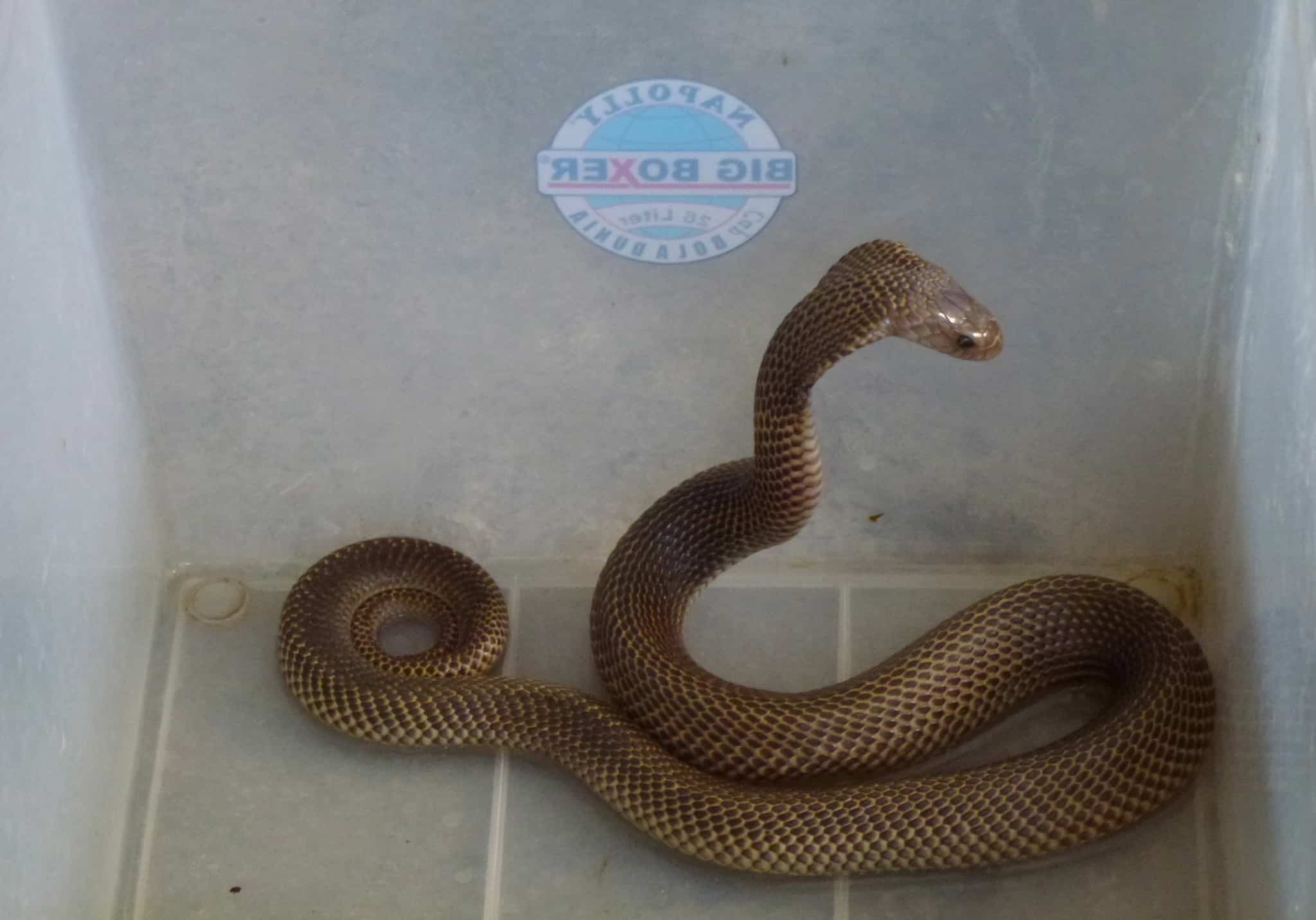
Maximum length: 185cm.
This spitting cobra is neatly confined to the large Indonesian island of Java, plus the Lesser Sunda islands to the east. It’s one of the least flashy species, varying from grey to nearly black, although there’s a cooler enclave with a white background and speckled black spots. Their belly is a simple white rather than the black-necked spitting cobra’s fleshy pink.
This species doesn’t hesitate to spit in people’s eyes. People have attempted to keep it in captivity, but as this guy found, they can take 2 years before they stop wildly spitting at their owners.
Naja sputatrix is a common species on Java. They mainly inhabit tropical forest and wet forest, but are comfortable elsewhere too. One of their hotspots is the Indonesian University (Universitas Indonesia) in west Java, one of the country’s most ancient education institutions. The Javan spitting cobra was the most commonly sighted snake in a 2021 survey, and in 2016, a student was bitten by one in the Department of Psychology, requiring serious medical attention. This spitting cobra commonly shows up in the slaughterhouses of central Java, captured for its skin and flesh.
| 6 | Ashe’s spitting cobra |
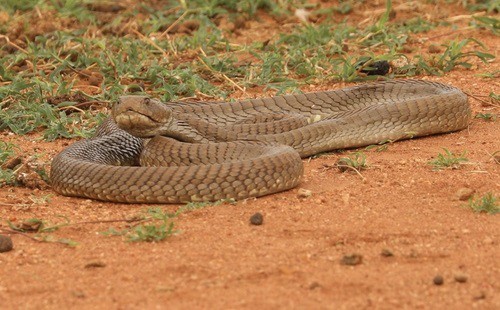
Maximum length: 270cm.
The largest spitting cobra species worldwide. This brute lives in east Africa, and co-exists with the red and black-necked spitting cobras. Originally, it was was considered a black-necked subspecies, but its browner colour was noticed in the 1960s, and in 2000 genetic analysis finally proved it to be an independent species. Ashe’s spitting cobra averages at 1.4-2 metres, whereas 2 metres is an extreme outlier for the red spitter. The official record was 2.7 metres long, from Kenya, which is officially the largest spitting cobra ever. Their heads are equally large and bulky.
Ashe’s spitting cobra also has a brutal temperament, never hesitating to spit at innocent people that accidentally set off its threat sensors. Supposedly, they can spit venom for hours without running out of stocks. The composition of their venom is similar to black-necked spitting cobras, with cytotoxins and neurotoxins aplenty. However, they inject a much higher quantity, in line with their large size.
Ashe’s spitting cobra resides in savannahs, both dry and wet, and occasionally semi-deserts.
| 7 | Equatorial spitting cobra |
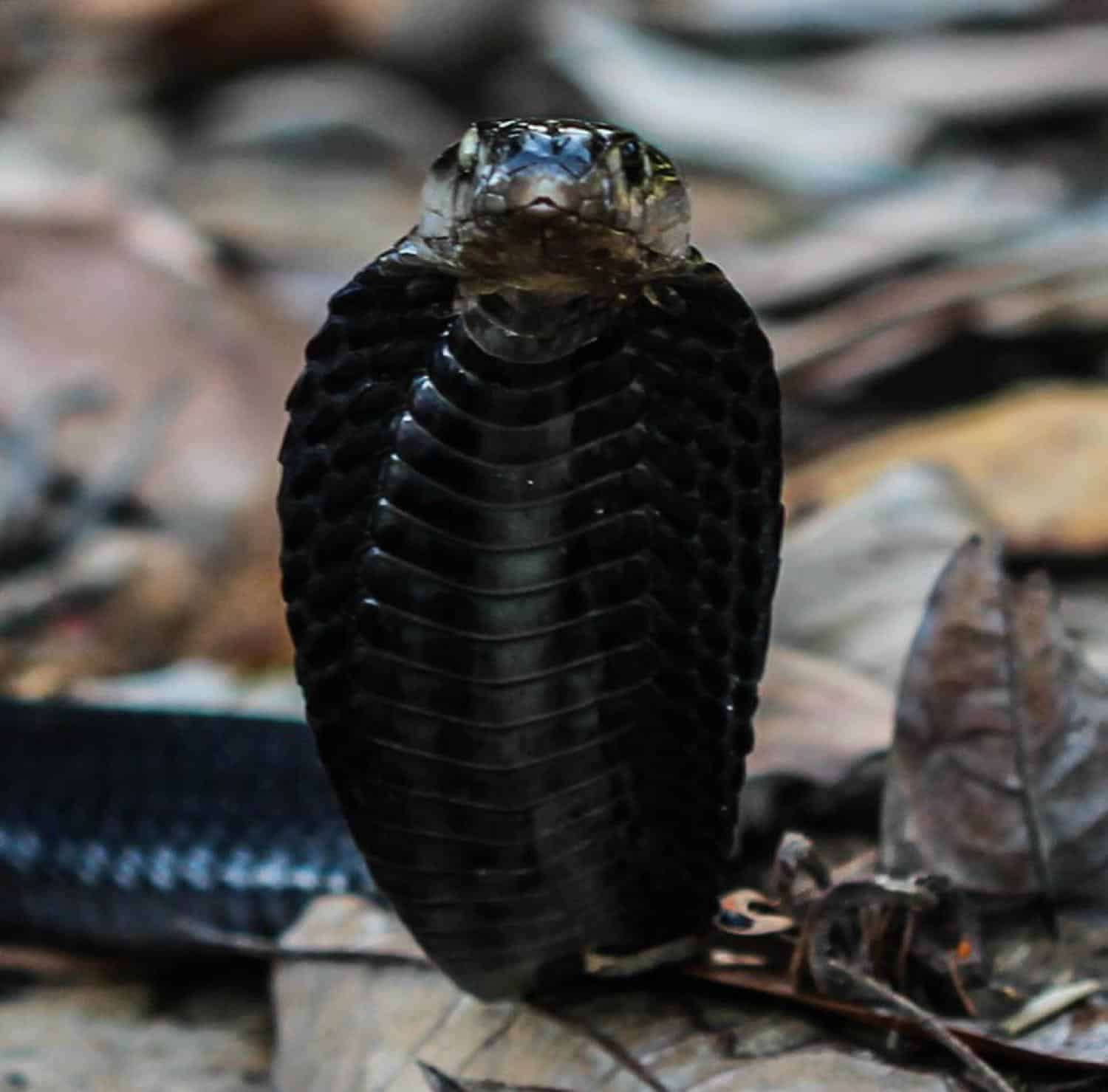
Maximum size: 160cm.
A common southeast Asian spitter, ranging from far southern Thailand to Malaysia to Indonesia. However, this spitting cobra doesn’t overlap with naja philippinensis or the Javan spitting cobra. Within Indonesia they skip Java, and in the Philippines they stick to the Palawan islands.
This is a spitting cobra that fires in thin jets over a fine mist. Their instinct is to aim for the eyes, causing red, painful wateriness, which can progress to temporary blindness and scarring if the victim is unlucky. However, they’re one of the less aggressive spitting cobras, taking a lot of abuse and bother before finally rearing up and firing. Their venom is particularly high in hyaluronidase, which burns through hyaluronic acid in skin tissue.
The equatorial spitting cobra has two colour morphs. In far south Thailand and northern peninsula Malaysia, they’re a golden yellow. But in the rest of their range, they’re a deep black, one of the blackest spitting cobras. This is mainly a forest dweller, but also strays into gardens.
| 8 | Mozambique spitting cobra |
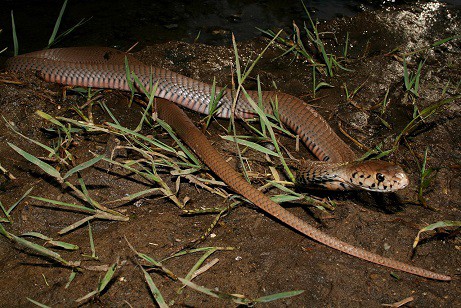
Maximum length: 180cm.
This spitting cobra is named M’fezi by the Zulu people of South Africa, and can occupy savannah, farmland, villages and forests alike. Spits from this species travel through the air at 10mph, and are accurate for 3 metres. A direct hit will result in 3 days of blindness, but permanent blindness is also possible. Like its African cousins, the Mozambique spitting cobra is a toad lover, particularly the clay-coloured African red toad. Its bite packs an equally nasty punch, causing skin and tendons to disintegrate.
Mozambique spitting cobras have one terrifying quality: they’re notorious for slithering into people’s bedrooms at night. A study found that 81% of bites happened while victims were sleeping, and 94% indoors, usually on toes and ankles. People often roll over unconsciously, not realising that they have a spitting cobra bedfellow.
Mozambique spitting cobras aren’t a calm snake. They’re twitchy and excitable, and won’t hesitate to spit. Another brutal feature is eating other snakes, including black mambas and puff adders. Rotting snake carcasses are another mouth-watering option.
Last but not least, this spitting cobra has the ability to crawl up toilet pipes.
| 9 | Mandalay spitting cobra |
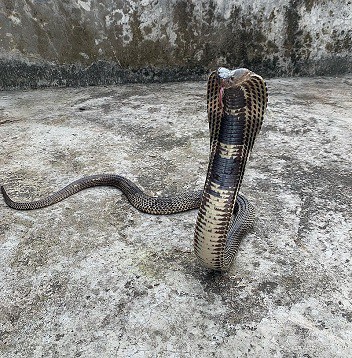
Maximum length: 140cm.
This is one of the rarest spitting cobras, restricted solely to the dry regions of inner Burma. This is a former savannah which is now agricultural land, and the resident spitting cobra was only identified as a species in 2000. Naja mandalayensis is a black snake, intermingled with beige. Rather than huge stripes, this beige is more intermingled with the black, as though the snake has had sand thrown over it.
Despite the lack of research, the Mandalay spitting cobra causes havoc in inner Burma. A study examined 8 locals sprayed in the eyes, and found that all experienced conjunctivitis, swelling, sharp pain, and temporary loss of vision. This is one of the angrier versions, as they require little provocation to start spitting repeatedly. They also hiss while slithering forward when bothered, and can spit 2 metres. A bite, meanwhile, results in necrosis and life-threatening neurotoxicity.
Mandalay spitting cobras are a nocturnal species, basking on the dry earth during the day. The downside to being recent is that no specific antivenin exists. Myanmar is also home to monocled cobras, which the general cobra antivenin works excellently against, but in Naja mandalayensis it’s less effective.
| 10 | Zebra spitting cobra |
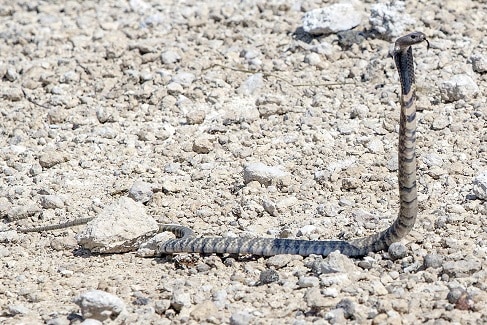
Maximum length: 193cm.
Another new spitting cobra species, a resident of southwest Africa. This was separated out of the black-necked spitting cobra species in 2007, like the Ashe’s spitter further north. All along, it turned out that Namibian villagers had been battling their very own spitting cobra – this version has alternating black and white stripes, and particularly likes dry areas. It’s often encountered by villagers on tarmac roads, particularly after rains.
The zebra sitting cobra lacks any fear of human beings. The snake will spit instantly, without even thinking, defaulting to aggression automatically. This is another spitting cobra that invades bedrooms – one unfortunate 7 year old boy was bitten on the face while he slept, and spat in his right eye for good measure. Miraculously, he survived. He received skin grafts and was discharged after 3 weeks, while his agonised right eye showed a corneal lesion which healed naturally.
Naja nigricincta is something of a terror in rural Namibia, and is mostly nocturnal (hence the bedroom invasion). It suffers from the same antivenin problems – most have been designed for the Mozambique spitting cobra and don’t work as well. This new spitting cobra can spit 9 feet (2.7 metres).
